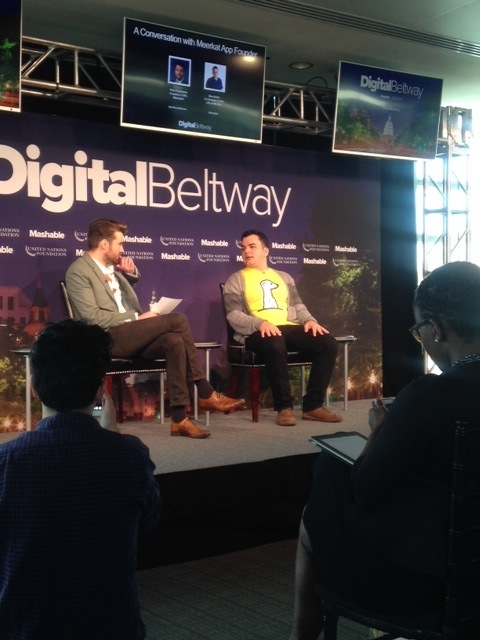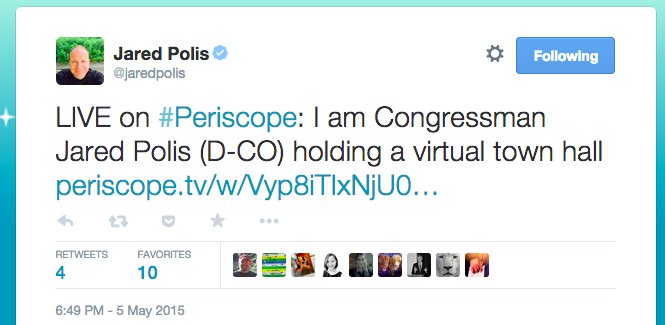Shana Glickfield’s post originally appeared on the blog of the Beekeeper Group, where she is a Partner and co-founder.
I recently connected with Congressman Jared Polis directly and without an appointment. No, I don’t have an “in†in the typical sense. Or do I? I got to connect with Congressman Polis because he frequently pops up on Periscope, the livestreaming video app now owned by Twitter.
Poli s announced his last minute “virtual townhall†and just a handful of us tuned in, demonstrating the benefits to getting in early on new livestreaming platforms. Polis was in a car (not driving, which he clarified off the bat) on his way to an event and had some time to chat. “What can I answer for you?†is not something we often hear from Members of Congress with unfettered access.
s announced his last minute “virtual townhall†and just a handful of us tuned in, demonstrating the benefits to getting in early on new livestreaming platforms. Polis was in a car (not driving, which he clarified off the bat) on his way to an event and had some time to chat. “What can I answer for you?†is not something we often hear from Members of Congress with unfettered access.
Polis isn’t the only one taking advantage of this type of technology. Other policymakers are finding this an efficient opportunity to “go live†with constituents, usually to involve them in their activities, but sometimes to open up for unscripted Q&A. Examples include an MSNBC interview with White House Press Secretary Josh Earnest, the US Secretary of Commerce swearing in Michelle Lee as the first female Director of the USPTO, and Jeb Bush livestreaming a speech that teased his Presidential candidacy announcement.
Nonprofits, associations, and individuals are doing the same. My feed was filled with livestreams of the recent WWII Air Show over the National Mall organized by Arsenal Democracy Flyover to commemorate the 70th anniversary of Victory in Europe (VE) Day. The other day I was on Twitter and happened to catch an attendee at an ASAE event streaming an interview with their CIO, Reggie Henry, on how associations should use technology.
 So why the recent interest in these platforms? I had the opportunity to hear from Meerkat Co-Founder Ben Rubin at the Digital Beltway conference who shared his thoughts on the surge of interest, including in public affairs. He believes that some of the appeal of livestreaming apps is likely driven by the opportunity for more honesty in social media. “Everyone knows a good photo when they post it on Instagram, but you never know if you’re going to get a good livestream.â€
So why the recent interest in these platforms? I had the opportunity to hear from Meerkat Co-Founder Ben Rubin at the Digital Beltway conference who shared his thoughts on the surge of interest, including in public affairs. He believes that some of the appeal of livestreaming apps is likely driven by the opportunity for more honesty in social media. “Everyone knows a good photo when they post it on Instagram, but you never know if you’re going to get a good livestream.â€
But even with the compelling call of a real-time, authentic stream, Rubin pointed out that you still need to give people a good reason to drop what they’re doing and tune in. In our current on-demand media world, people are used to deciding when they tune in. But if you provide that reason, “you’ll get something even better – you’ll get more undivided attention.â€
Another reason for the ‘why now?’ While livestreaming apps are not new (Ustream, Qik, etc.) there is a bit more of a tipping point now that the distribution is going through major social platforms like Twitter and Facebook (Meerkat is owned by Facebook). Also, Meerkat allows you to schedule a stream, post your upcoming stream, and then you can put ad dollars behind promoting the upcoming stream. Of course, there’s also push notifications, which Meerkat is now offering on desktop.
So, will our social media habit shifts from on-demand to time-sensitive? Will we start to drop everything to get in on a stream, even if we know it is scripted? Will FOMO win again?
My bet is yes, yes, and yes.
“Meerkat (Suricata suricatta) Tswalu” by Charlesjsharp – Own work, from Sharp Photography, sharpphotography. Licensed under CC BY-SA 4.0 via Wikimedia Commons


